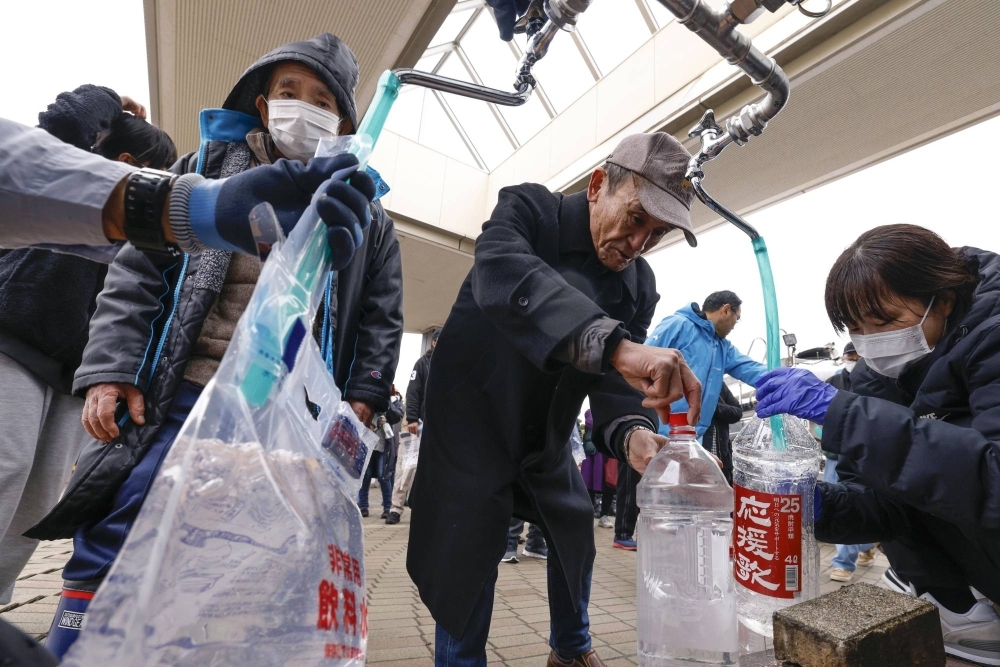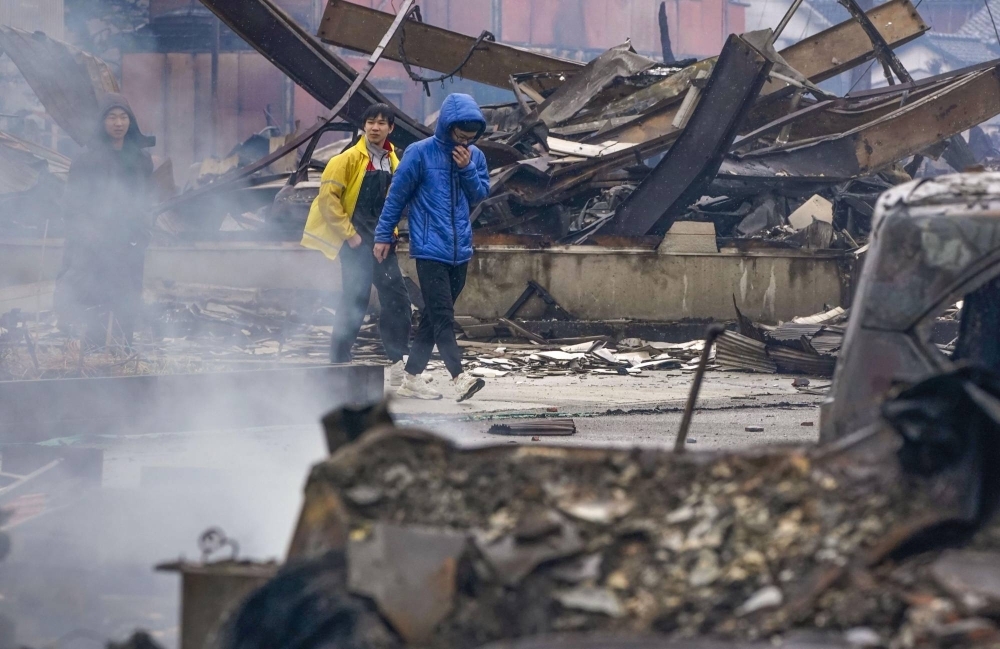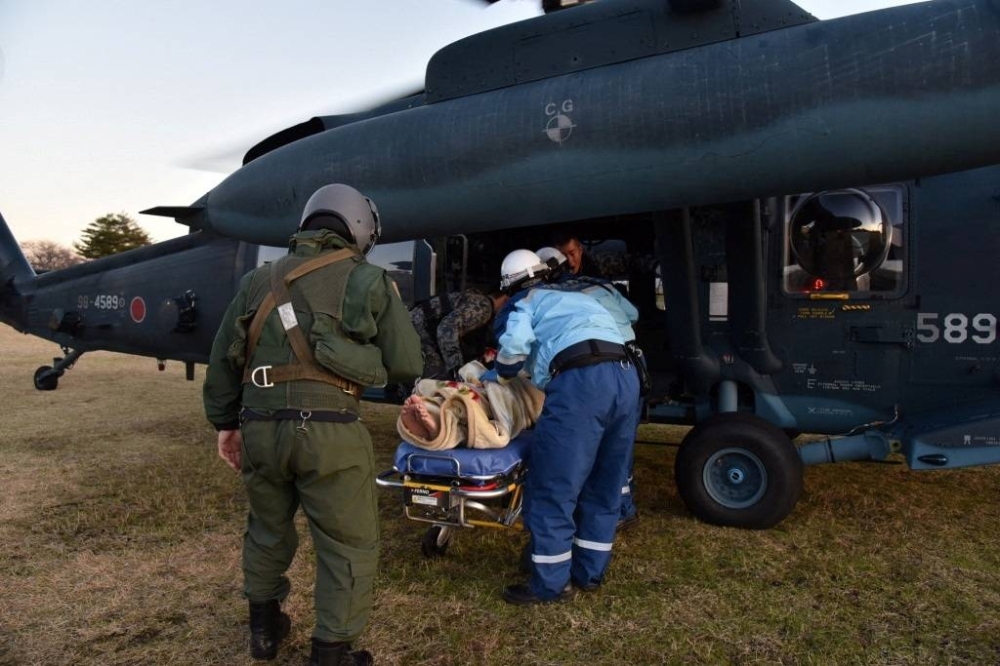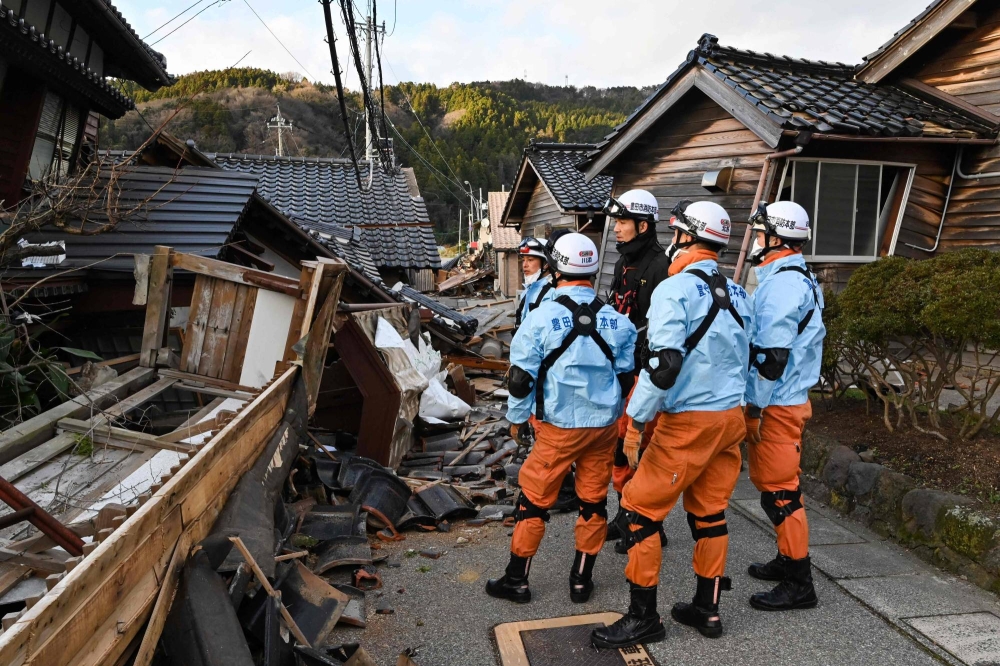Rescue efforts in Ishikawa Prefecture are continuing with heightened urgency in the wake of the powerful earthquake on New Year’s Day that left at least 65 dead and over 300 injured, with the crucial window for rescue efforts rapidly closing.
Over 33,000 people are staying in evacuation centers with limited access to electricity and water.
Aftershocks continue in the area, and Wajima experienced a quake measuring level 5 on the Japanese earthquake intensity scale Wednesday morning. The meteorological agency has warned that the wider prefecture could experience another level 7 tremor — the same strength as the first major quake on Monday — within the next week.
In addition, the weather observatory in the prefectural capital Kanazawa issued warnings for heavy rain in some of the worst-hit areas on Wednesday evening, further complicating rescue attempts and raising the risk of landslides.
The severest damage has been seen in Wajima, Suzu and Nanao, where many buildings have collapsed, with people still buried under the rubble. As of Wednesday morning, over 200 houses had been confirmed to have been wholly or partially destroyed within Ishikawa Prefecture. However, the entire scale of the destruction has yet to be determined, given that the number of damaged buildings in the hardest-hit areas has not yet been ascertained.
As of 8 a.m. on Wednesday, there had been around 130 requests for the rescue of people buried under collapsed buildings. In Suzu, there were over 72 requests for rescue that had yet to be answered. In Noto, Anamizu and Nanao, an estimated total of over 60 people were isolated and cut off from any aid.
“It has been over 40 hours since the earthquake and there continue to be many reports of people who need rescue,” Prime Minister Fumio Kishida told a news conference on Wednesday morning. “We must keep in mind that this is a race against time and continue to put all our labor into rescue efforts, with life-saving as our top priority.”
After the so-called golden 72 hours following an earthquake, the survival rate drops significantly.

People receive a supply of water in Shika, Ishikawa Prefecture, on Wednesday.
| KYODO
Starting Wednesday, the number of Self-Defense Force members deployed on the ground was increased to 2,000 from 1,000, while the number of rescue dogs was doubled, Kishida said. Over 2,000 firefighters and 700 police officers from around the country have also been deployed.
A major fire that broke out in Wajima near the popular tourist area of Asaichi on the day of the quake left around 200 stores and houses burned to the ground, with the fire having spread over 4,000 square meters.
Suzu Mayor Masuhiro Izumiya said Tuesday that out of the 6,000 houses in his city, between 4,000 to 5,000 of them are now “unlivable” due to damage from the earthquake.
Around 33,000 people in Ishikawa had evacuated as of Wednesday morning, sheltering at one of the 355 evacuation centers around the prefecture.
In Nanao, many houses have no access to water, electricity or gas. Cracks in the street and broken cobblestones can be seen across the area, while many houses are severely damaged, with some having completely collapsed. Five people are reported to have died in the city.
Firefighters and rescue cars dispatched from as far away as Gifu Prefecture were lined up along the highway.
One of the areas that has been turned into an evacuation site in Nanao is Misogichiku Community Center.
Among the 150 sheltering there were mother and daughter Harumi and Tsukasa Tamoto, whose home was rendered unlivable. The glass window at the entrance has shattered and the door could not be locked. Their husband and father had gone to fix the house during the day.

People inspect the extent of damage from fires in Wajima on Wednesday.
| KYODO
“The most difficult part is that there’s no water (at the evacuation center),” 35-year-old Tsukasa Tamoto said. Evacuees must collect it from houses that have running water.
Harumi Tamoto, 67, who cannot walk very well due to a lower back problem, also said that she could not relax because of aftershocks, which happened several times throughout the day. She is afraid that she would not be able to escape if another earthquake or tsunami warning is issued.
However, she is thankful that people have come together to help out those in need, with some people providing food for those affected and donating money, and others offering to take elderly people to the hospital. Grocery stores have also donated food.
As of 11 a.m. on Wednesday, around 33,800 houses in Ishikawa were still experiencing power outages. In Ishikawa, Niigata and Toyama prefectures, access to water is also difficult, and in some areas the SDF is deploying tankers to distribute water to residents, with people lining up for hours to collect some.
Due to road blockages, supply vehicles, including water tankers, have been unable to reach many areas in need of aid, such as Wajima, Suzu and Nanao — many people in the affected areas have taken to social media to highlight the lack of supplies. On Wednesday, Suzu’s Mayor Izumiya said there was an urgent lack of portable bathrooms in his city.

Self-Defense Force helicopter crew members transport a patient in Suzu, Ishikawa Prefecture, on Tuesday.
| Joint Staff Office of the Defense Ministry of Japan / VIA REUTERS

A man who visited the site of a fire in Wajima on Wednesday said he did not know of fires following a major quake hitting the area two days before because he lost electricity access and could not watch the news on TV.
| KYODO
Kishida said that the government was expediting aid to these areas, having managed to secure a route to Wajima on Wednesday that a 4-ton truck could pass through. A delivery of supplies reached Ishikawa, and were distributed to affected cities from early Wednesday.
Authorities are trying to establish a supply route via the sea, given that Wajima and Suzu are located on the Noto Peninsula, though the plan has so far been hampered by capsized ships crowding the sea near the affected communities, transport minister Tetsuo Saito said.
The Maizuru coast guard office located in Kyoto Prefecture said that although it did not cover Ishikawa Prefecture, they were offering boats to aid the delivery of supplies given their location on the Sea of Japan side of the country.
“It is yet to be specifically carried out, but there are plans for boats in the District 8 area to help deliver goods (to affected areas),” said Shuhei Umeda, a coast guard official on duty in Maizuru.
While damage is particularly severe in Ishikawa, neighboring Toyama and Niigata prefectures have also been badly affected. The health ministry said that, as of Wednesday morning, over 110,000 households in the three prefectures did not have access to water.
More information:

